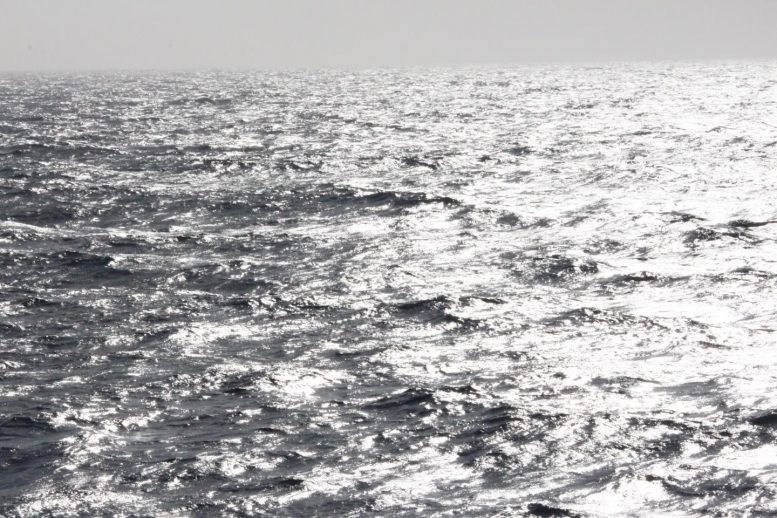
The Southern Ocean, southeast of Tasmania. Credit: IMAS
A mystery that has baffled scientists for more than two decades is being solved by new study on the chemistry of the oceans during ice eras.
The question is how much CO2 entered the ocean throughout the ice ages that can be attributed to the “biological pump,” where atmospheric carbon is absorbed by phytoplankton and deposited to the bottom when organisms die and sink.
The mystery must be solved in order to increase the accuracy of climate models and get a better knowledge of how ocean systems may respond to future climate change.
Led by IMAS and University of Liverpool scientists and published today (October 10, 2019) in Nature Communications, the study found ice age phytoplankton in the tropics absorbed high levels of CO2 due to fertilization by iron-rich dust blowing into the ocean.
Lead author Dr. Pearse Buchanan said that until now models had only been able to explain a portion of the CO2 that entered ice age oceans via the biological pump.
“During past ice ages, carbon levels were lower in the atmosphere and higher in the oceans than today, but scientific models aren’t able to account for all of the additional CO2 that entered the ocean,” Dr. Buchanan said.
“The leading hypothesis has been that iron-rich dust blown from glacial landscapes stimulated phytoplankton growth in high latitudes, but this only explained around one-third of the extra CO2 absorbed through the biological pump: the other two-thirds was effectively “missing.”
“We used an ocean model to look at the response to iron-rich dust of phytoplankton in tropical waters, particularly a group of phytoplankton called “nitrogen fixers.”
“These are able to biochemically “fix” nitrogen from the atmosphere, much like nitrogen-fixing bacteria that help legume crops thrive in nutrient-poor soil.
“Marine nitrogen fixers are known to be important in the marine nitrogen cycle, and now we’ve shown they’re also critically important in the marine carbon cycle.
“When we added iron to our ocean model, nitrogen fixers thrived, and their growth and subsequent sinking to the deep ocean can account for much of the missing CO2,” Dr. Buchanan said.
IMAS Associate Professor Zanna Chase said this solution was first proposed in 1997 but had gained little traction over the last two decades.
“The beauty of this approach is that it can explain almost all of the additional CO2 that phytoplankton transported into the oceans during the last Ice Age,” Associate Professor Chase said.
“The increased activity of the biological pump in the tropics complemented that happening in colder waters, drawing higher levels of CO2 into the oceans and locking it away in the deep ocean.
“This pathway for carbon to the deep ocean is reduced today because less fertilizing iron is being circulated by the wind and phytoplankton growth, including that of nitrogen fixers, is correspondingly limited, although there are signs that it has strengthened within the Pacific since the industrial revolution.
“Taking account of these links between the cycles of iron, nitrogen, and carbon in our ocean and climate change models will make them better able to explain ocean processes and predict future changes.
“But how iron fertilization of phytoplankton will evolve is currently uncertain, undermining our ability to predict the ocean’s role in drawing CO2 out of the atmosphere in the coming centuries,” Associate Professor Chase said.
Reference: “Marine nitrogen fixers mediate a low latitude pathway for atmospheric CO2 drawdown” by Pearse J. Buchanan, Zanna Chase, Richard J. Matear, Steven J. Phipps and Nathaniel L. Bindoff, 10 October 2019, Nature Communications.
DOI: 10.1038/s41467-019-12549-z



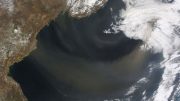
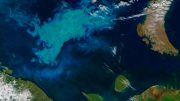
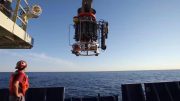

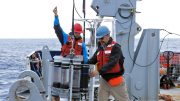
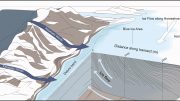
Subject: Climate Change
Recently, on June 28, 2019, a scholarly journal that is maintained by the top-ranked journal Nature published a scientific research paper, titled “Intensified East Asian Winter Monsoon During the Last Geomagnetic Reversal Transition” by a group of Japanese scientists which found according to its lead investigator that “The umbrella effect caused by galactic cosmic rays is important when thinking about current global warming, as well as, the warm period of the medieval era.” When the journal Nature is willing to print such a contradictory piece of research it is clear that the science is in a state of flux. This remarkable finding confirmed the result found by Profs. Kauppinen & Malmi, both from Finland, in a paper titled “No Experimental Evidence For Significant Anthropogenic Climate Change” (June 29, 2019) that “… the (IPCC) models fail to derive the influence of low cloud cover fraction on global temperature. A too-small natural component results in a too-large portion for the contribution of greenhouse gases like CO2. The IPCC represents the climate sensitivity more than one order of magnitude larger than our sensitivity 0.24 degrees C. Because the anthropogenic portion in the increased CO2 is less than 10%, we have practically no anthropogenic climate change. The low clouds control mainly the global temperature.” The South China Morning Post on Aug. 11, 2019, next reported that “A new study has found winters in Northern China have been warming since 4000 BC — regardless of human activity — “. This research was published in the Journal of Geophysical Research: Atmospheres and concluded that human activity “… appears to have little to due with increased greenhouse gases.” The “driving forces include the Sun, the atmosphere, and its interaction with the ocean” but “We have detected no evidence of human influence.” This study’s findings confirm an earlier study that was published in Scientific Reports in 2014. Most importantly, the lead investigator for the Kobe University research paper insisted that “… she is now more worried about cooling than warming.” Compellingly, on Sept. 23, 2019, over 500 climate experts delivered a letter to UN secretary-general, Antonio Guterres, which states (in bold) that “THERE IS NO CLIMATE EMERGENCY” and that “The general-circulation models of climate on which international policy is at present founded are unfit for their purpose.” Amazingly, no mainstream news organization has reported any of these facts.